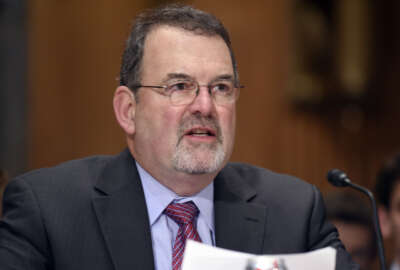
Advice for the new Federal CIO Suzette Kent from those who came before her
Seven former federal CIOs and deputy CIOs share lessons learned with the incoming Federal CIO.
The White House finally named a new federal chief information officer on Jan. 19 after a year of waiting. Suzette Kent comes to the government with little or no background in the public sector and no clear information technology background, according to her LinkedIn profile.
And that may be a good thing in many regards. But at the same time, she has a steep learning curve of acronyms, the sometimes archaic procurement rules, and, of course, a 535-person board of directors, whose opinions change like the wind.
Federal News Radio asked those who came before Kent at the Office of Management and Budget for some insights, advice and words of wisdom as she takes on this new role. Here is some of what they told us:
WFED: Based on your experience what were some of the areas that you saw as your biggest learning curves when you became federal CIO? How did you shorten the timeframe to learn what you needed to know?
Mike Howell, former deputy CIO and now senior director for the Institute for Innovation and Special Projects at the Industry Advisory Council-American Council for Technology:
“Learning how to function effectively in the nexus of the executive and legislative branches of the federal government (including the Government Accountability Office), interact with White House leaders, offices, and governance bodies (e.g. National Security Council and Office of Science and Technology Policy), engage with OMB components (budget and resource management office program leaders), bridge technology and mission program communities, and engage agencies (including senior leaders, mission programs, and support function – CIOs, CAOs, CFOs and CHCOs), and the private sector. It is like trying to conduct a REALLY large orchestra of people who have not played together before to perform a complex, difficult piece of music.”
Tony Scott, former Federal CIO and currently the CEO of the Tony Scott Group:
“Fortunately [former OMB deputy CIO] Lisa Schlosser had put together a great primer on what OMB does, what the role of the CIO is, how we are organized and the current stuff we were working on. I got that a few weeks before I started and had a chance to bone up and understand a lot of that stuff. Then along with that primer came a bunch of question so even before I started I had a great start. I’m sure [current deputy CIO] Margie [Graves] has done same thing and will be helpful for Suzette coming in.
The stuff I was unprepared for was testifying before Congress. I had talked at board meetings, before audit committee, and at public meetings, but I didn’t come into the job with an understanding of being able to tell lawmakers ‘here’s what these things are and how they work.’ This was a case where OMB staff did a tremendous job with fake trial runs where you get asked tough and tricky questions. That prep was super helpful, and a learning that is unique to these kinds of roles.”
Tim Young, former OMB deputy CIO and currently a principal with Deloitte Digital:
“Understand how to influence change by using the budget process – both budget formulation and budget execution. While OMB controls budget formulation, Congress controls the enactment and you have to work with congressional appropriations committees before and during management reform agenda implementation. Even the most thoughtful strategies can fail without sufficient resources and authorization.”
Steve VanRoekel, former federal CIO:
“Exercise patience and focus understanding that things move a bit slower than the private sector. We showed that you can be successful and accomplish many things – like the U.S. Digital Service, the Presidential Innovation Fellows, PortfolioStat, our Open Data orders, our work on cloud computing and other reforms – but it takes a much different approach than the private sector.”
WFED: What’s the best advice you received about being federal CIO from others in or out of government?
Mark Forman, former administrator for e-government and currently global head, vice president and general manager, Public Sector, Unisys:
“You’re not doing your job until a secretary calls the OMB Director to get you fired for driving the agency too hard to change.”
Karen Evans, former administrator for e-government and currently head of the U.S. Cyber challenge:
“To reach out to both and industry/departments and agencies but especially oversight with Congress and listen.”
Tim Young:
“Focus on ‘getting it right’ vs. ‘being right.’ Some of your management reform initiatives will fall short of their objectives. Even the best-planned ideas can fail to achieve their envisioned outcomes. Acknowledge this along the journey, move on, and pay-it-forward instead of trying to salvage a futile political victory.
Implement reforms ‘with’ the agencies, not ‘to’ them. Some mandates will be required in the form of Executive Orders, budget guidance and policy memoranda, but first utilize the power of collaboration and transparency to build the trust and buy-in needed for enduring enterprise change.”
Mike Howell:
“Make time to consult, strategize, think and plan – don’t let the multitude of urgent, daily crises consume all of your capacity.”
Steve VanRoekel:
“The best advice I received was really about building great relationships from the start. If you fight or belittle the career staff or bring political views into your meetings with Congress, you will get very little done. Having empathy for the amazing women and men in the Federal service, inspiring them to bring their best to their work in service of the American people and going along on the journey with them is always a winning strategy.”
WFED: What was your biggest frustration about being federal CIO? What’s the biggest challenge you saw to being federal CIO?
Lisa Schlosser, former OMB deputy CIO and now an instructor at Georgetown University:
“The lack of real understanding of the business value of technology, and the difficulty in getting support for the modernization of systems and acquisition processes.”
Mark Forman:
“It was very frustrating when agency CFOs went around OMB to Congress to undercut administration strategy and shared services initiatives. Biggest challenge is too many players have legal authority putting them ‘in charge.’”
Tony Scott:
“My biggest frustration was the arcane set of rules that sometimes you feel imposed on you. Two specific ones were the inability to easily get unsolicited proposals and the Paperwork Reduction Act. In the private sector, you live and breathe every day on the supply community that you are involved with coming up with unsolicited ideas and you encourage them to get to know organization and put on their creative thinking caps. In the federal government because of the procurement process, it’s just not a vibrant process. In fact it’s hardly exercised at all, and when it is, it’s not a very well done process. Because of that we are missing out on tons of innovations. If we could figure out a way to reform that area, I think it would be hugely valuable, and it would turn on the creativity of those who serve the federal government.”
Karen Evans:
“Trying to move fast!! Ensuring the budget resources aligned with the implementation plans and measuring and demonstrating success.”
Tim Young:
“Deviating from status quo takes time and will always be met by some resistance. Recognize that someone (or a group of people) established status quo and getting them to adopt a new initiative or program takes time and substantial energy. Effectively navigating the federal bureaucracy requires focus, resilience, and purpose.”
Read more of the Reporter’s Notebook.
Copyright © 2024 Federal News Network. All rights reserved. This website is not intended for users located within the European Economic Area.
Jason Miller is executive editor of Federal News Network and directs news coverage on the people, policy and programs of the federal government.
Follow @jmillerWFED
Related Stories





